 Technology
Technology  Technology
Technology  Humans
Humans 10 Everyday Human Behaviors That Are Actually Survival Instincts
 Animals
Animals 10 Animals That Humiliated and Harmed Historical Leaders
 History
History 10 Most Influential Protests in Modern History
 Creepy
Creepy 10 More Representations of Death from Myth, Legend, and Folktale
 Technology
Technology 10 Scientific Breakthroughs of 2025 That’ll Change Everything
 Our World
Our World 10 Ways Icelandic Culture Makes Other Countries Look Boring
 Misconceptions
Misconceptions 10 Common Misconceptions About the Victorian Era
 Mysteries
Mysteries 10 Strange Unexplained Mysteries of 2025
 Miscellaneous
Miscellaneous 10 of History’s Most Bell-Ringing Finishing Moves
 Technology
Technology Top 10 Everyday Tech Buzzwords That Hide a Darker Past
 Humans
Humans 10 Everyday Human Behaviors That Are Actually Survival Instincts
 Animals
Animals 10 Animals That Humiliated and Harmed Historical Leaders
Who's Behind Listverse?

Jamie Frater
Head Editor
Jamie founded Listverse due to an insatiable desire to share fascinating, obscure, and bizarre facts. He has been a guest speaker on numerous national radio and television stations and is a five time published author.
More About Us History
History 10 Most Influential Protests in Modern History
 Creepy
Creepy 10 More Representations of Death from Myth, Legend, and Folktale
 Technology
Technology 10 Scientific Breakthroughs of 2025 That’ll Change Everything
 Our World
Our World 10 Ways Icelandic Culture Makes Other Countries Look Boring
 Misconceptions
Misconceptions 10 Common Misconceptions About the Victorian Era
 Mysteries
Mysteries 10 Strange Unexplained Mysteries of 2025
 Miscellaneous
Miscellaneous 10 of History’s Most Bell-Ringing Finishing Moves
10 Fascinating Facts About The American Flag
To many Americans, the flag of the United States of America is a symbol of national pride that they display on flagpoles in front of their homes, on their clothing, and pretty much everywhere. Few countries enjoy the considerably ubiquitous nature Americans have with their flags, which may seem strange to anyone not from the United States.
The reasons for the Americans’ love of their flag are deeply rooted in the nation’s history, but not many people know as much about the flag as they think they do. Many of the “facts” taught to American schoolchildren are not as accurate as teachers may believe. To dispel the myths and attempt to explain its history, here are ten fascinating facts about the American flag.
10 It Didn’t Always Have 13 Stripes
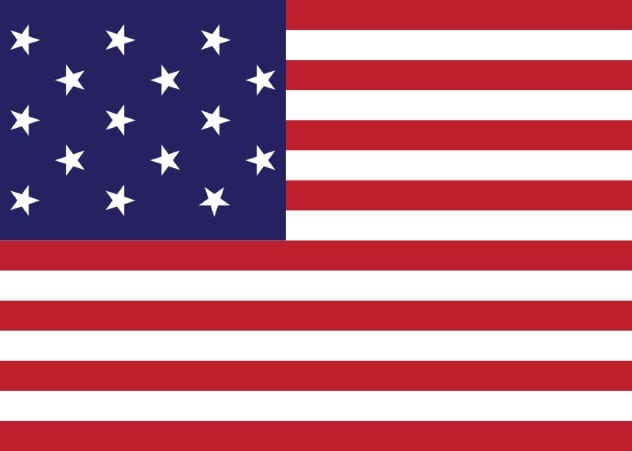
Pretty much everyone familiar with it knows the American flag has 13 stripes representing the 13 original colonies that came together to form the nation. Seven red stripes and six white ones have been emblazoned on the flag since its inception . . . that is of course, until those stripes increased to 15. Back when Vermont and Kentucky joined the Union in 1791 and 1792, the nation was faced with a design issue. To incorporate the appropriate number of states, the flag was redesigned to include 15 stripes.
It quickly became apparent that with a massive amount of territory spreading to the West, other states would eventually join the Union, and that represented a further challenge. Should the country continue adding stripes to represent each state or go another way? It was decided that the flag would revert to the original design of 13 stripes representing the 13 original colonies and has remained that way ever since. The 15 Star Flag flew over the United States for 23 years before the original concept was re-implemented. Five US presidents served under the flag between 1795 (Washington) and 1818 (Monroe).[1]
9 There Have Been 27 Versions Of The Flag
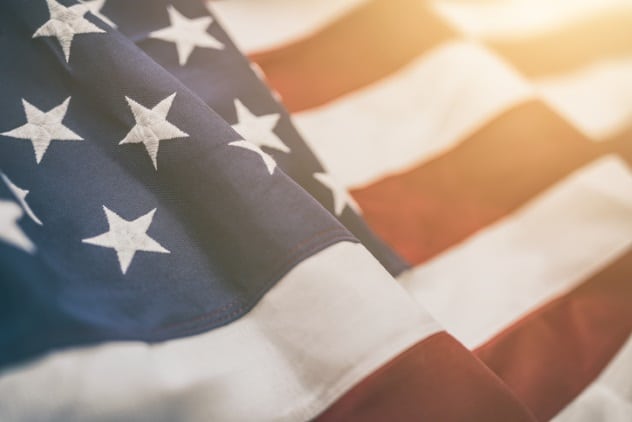
Over the years, the United States grew from its 13 original colonies to include 50 states. As each state joined the Union, it became necessary to reflect this on the flag. The US is unique in this way, as most countries do not modify their flags for such a reason, preferring to retain a national flag that remains static in design. The United States prefers to reflect the changing and growing nature of its makeup after one or more states join the Union.
As many flag redesigns came following the inclusion of two or more states, the new look didn’t always come right away. This allowed for designs to be submitted by regular citizens as well as the legislature. While the stripes have remained the same for most versions, the star field has held many interesting patterns. Some less-than-official versions that have flown above Army forts included stars arranged in circles, a diamond, and even a star.[2] When North and South Dakota were introduced, many flag manufacturers jumped the gun and designed a flag with 39 stars, falsely believing they would be combined into one state.
8 A High School Student Created The 50-Star Design
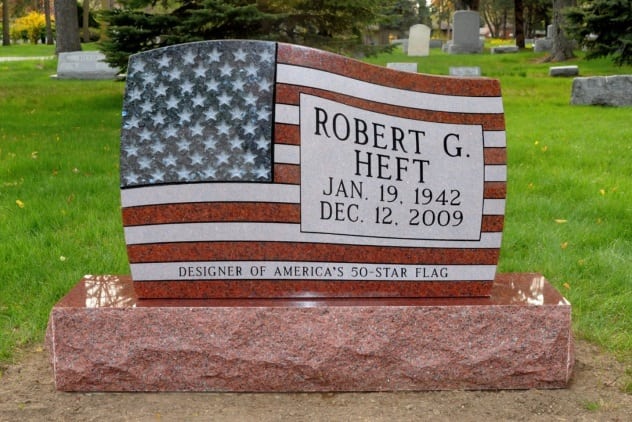
When the United States welcomed Alaska and Hawaii into the fold in 1959, the call for a new flag design went out to the nation, and it was answered by an unlikely source. People from all over the country embraced the challenge, but it wasn’t a professional vexillologist (the fancy name for a flag enthusiast) who came up with it. It’s unlikely anyone thought a student’s project would be picked, but that’s exactly what happened when Ohio native Robert “Bob” Heft’s flag was submitted for consideration.[3]
Having never sewed a day in his life, Bob put together his 50-star design using iron-on material and some fabric. He put his new design over his family’s 48-star flag and brought it into class. His teacher was confused with his project, seeing as he made it with 50 stars before either state was admitted to the Union, and slapped him with a “B-.” Heft recalled the teacher saying, “If you don’t like the grade, get it accepted in Washington.” Fast-forward to the present, and Bob’s 50-star design has remained for over 50 years—the longest for any American flag. Before his passing in 2009, Heft designed a 51-star pattern should the United States welcome Puerto Rico.
7 An Actual Flag Inspired The National Anthem
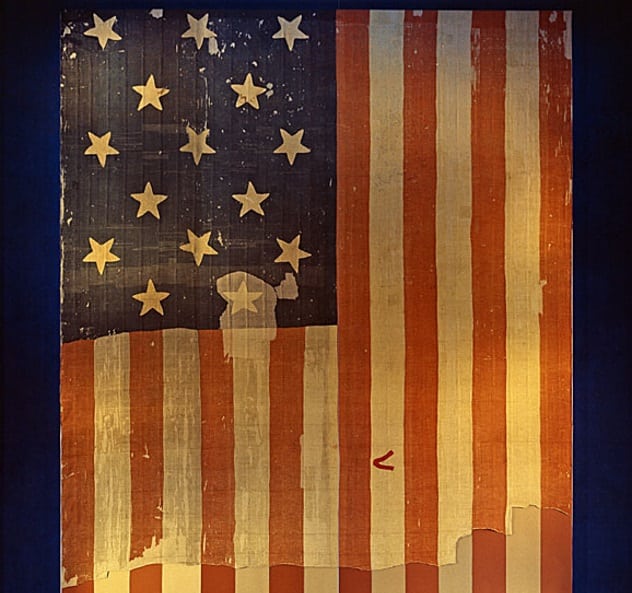
The poem written by Francis Scott Key that became the US national anthem was inspired by the nation’s flag. Key wrote the poem during the bombardment of Fort McHenry on September 13, 1814. While it may seem obvious that a poem about a flag was inspired by one, what many people don’t know is that the flag in question still exists! It can be seen at the Smithsonian in Washington, DC.[4] The first thing people notice about the flag is that it’s missing some pieces. It’s pretty old and was in a bombardment, so you might think it was simply left in tatters, but pieces were actually cut off and sold over the years.
The most recent auction occurred in 2011 in Dallas. A small scrap containing white and red with a seam sold for $65,725. The cutting was likely made back in the 19th century, when many pieces were removed. Another interesting aspect of the flag many people gloss over is that it is a 15-star, 15-stripe version. That design was in place throughout the War of 1812, which is why it flew as the Great Garrison Flag of Fort McHenry.
6 The Colors Have Meaning
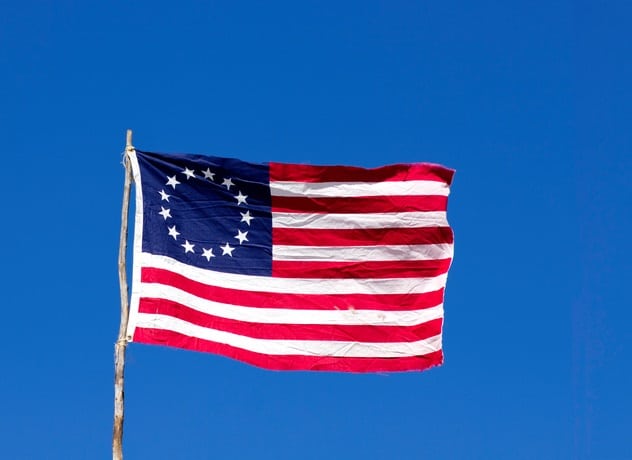
It’s fairly well-known that the white stars on the American flag represent the nation’s 50 states, while the 13 red and white stripes are there for the 13 original colonies. While those colors may seem arbitrary, they have meaning, and there’s a reason they are on the flag. When you think about it, the country could have adopted any colors they wanted. They might even have chosen ones that weren’t on the British flag, seeing as they fought a war for independence from Britain, but they chose red, white, and blue.
Interestingly, the colors for the flag adopted in 1777 did not have any meaning at all! It wasn’t until the Great Seal of the United States was created in 1782 that those colors were retroactively given a meaning. Charles Thompson, secretary of the Continental Congress, reported to the following to Congress:
The colors of the pales (the vertical stripes) are those used in the flag of the United States of America; White signifies purity and innocence, Red, hardiness & valour, and Blue, the color of the Chief (the broad band above the stripes) signifies vigilance, perseverance & justice.[5]
5 The First Flag Was Commissioned Via A Native American
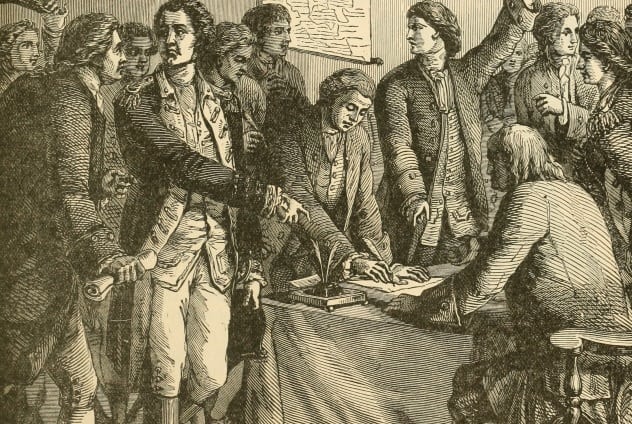
A year into the American Revolution, and the newly proclaimed United States of America still had no official flag. The year was 1777, and a Native American named Thomas Green was planning a trip to Philadelphia. He was concerned that he couldn’t travel the territory safely and thought it would be a wise decision to fly the nation’s flag for protection. The only problem was that no such flag existed, so Green petitioned Congress to get it done. He even offered three strings of wampum as payment! Congress acted, and within only ten days, a resolution was passed.
The Second Continental Congress passed the Flag Resolution on June 14, 1777, which became known as Flag Day in the United States. The resolution called for “the flag of the thirteen United States be thirteen stripes, alternate red and white; that the union be thirteen stars, white in a blue field, representing a new constellation.” Green’s payment was made, and the flag was designed, but they probably would have gotten around to it eventually without his request.[6]
4 Betsy Ross May Not Be As Important To The Story As We Thought
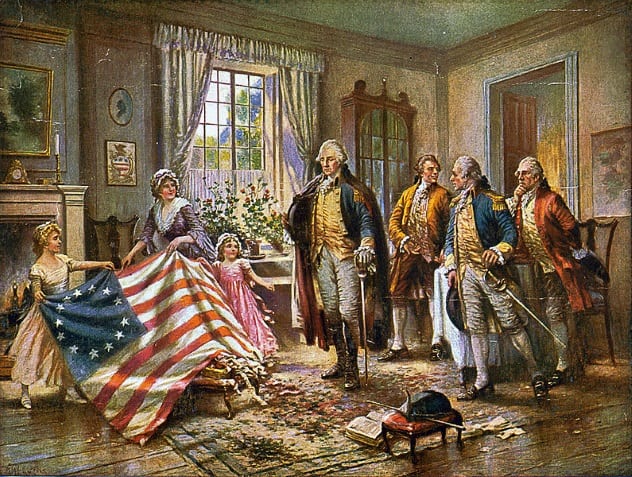
Betsy Ross is well-known to American schoolchildren as the woman who designed the first American Flag upon request by George Washington. As we previously mentioned, Ross wasn’t involved in the creation of the first flag, and as it happens, her name wasn’t even tied to the story until 1876, which was 40 years after her death. That isn’t to say Ross wasn’t involved in the production of American flags during her lifetime; she sewed quite a few in her day.
The story goes that a Congressional committee approached Ross in 1776 to create the flag, which she designed from their concept. There is no evidence that this event ever occurred, nor is there anything indicating that Congress sent such a commission. Ross and her shop became heavily involved in the production of naval flags as well as American flags later on, but her involvement in the flag’s creation and the story told for centuries may be little more than a pleasant fable.[7] Nevertheless, Ross has become a folk hero in American culture and a hero of the revolution.
3 Burning The Flag Is The Proper Way To Dispose Of One
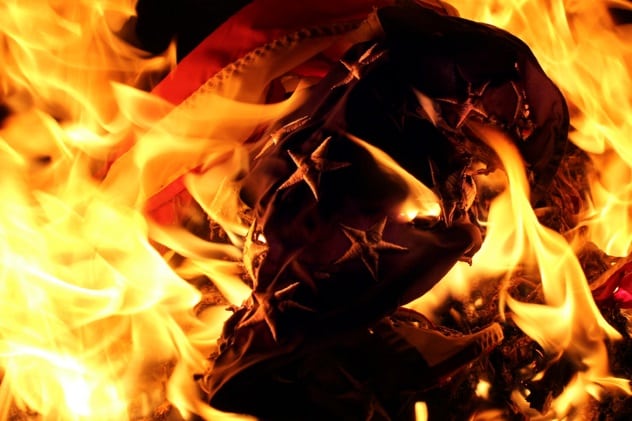
One of the most common ways to protest in the United States has been to burn the American flag. This has been happening since the flag was first created, but what many people don’t know is that the proper way to dispose of a flag is to burn it. This may seem counterintuitive, but the US Flag Code specifically outlines the proper ways to raise a flag, lower it, when to use it, what type of flag to use, and even how to get rid of one: “The flag, when it is in such condition that it is no longer a fitting emblem for display, should be destroyed in a dignified way, preferably by burning.”[8] This can be done by wholly burning the flag or by separating its seams and burning the individual colors.
There is even a long-standing myth in the United States military that revolves around proper flag destruction. It is said that within the finial, the golden ball atop flagpoles, there exist three items: a match, a razor blade, and a bullet. The story suggests that when a fort is taken by the enemy, a soldier can scale the pole and retrieve the items—the razor for cutting the seams of the flag, the match to burn it, and the last bullet to defend the base (or shoot oneself, depending on the story). While this tale is nothing but a military myth, the proper disposal of the flag by burning is not.
2 That Being Said, No Laws Truly Protect The Flag
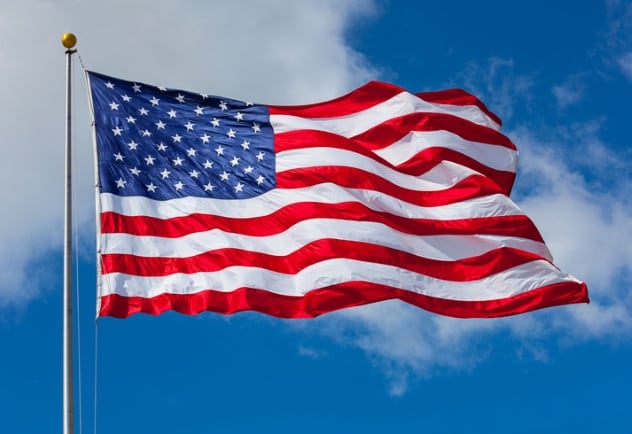
Many people in the United States incorrectly believe the flag is protected by various laws. As it happens, no true laws exist that would lead to civil or criminal penalties should someone desecrate or destroy a flag, and there’s a good reason for that. As a symbol of freedom, the flag is meant to be proudly displayed or desecrated and destroyed. It’s a symbol, and restricting a person’s right to do what they want with it would be antithetical to everything the flag represents.
That’s not to say people haven’t tried to establish laws protecting the flag. During the Vietnam War, the 90th Congress passed a law that became known as the Flag Protection Act in 1968. That law sought to protect the dignity of the flag and punish those who abused it. It was finally struck down in 1990 (United States v. Eichman) by the Supreme Court when they stated that the preservation of the flag as a symbol doesn’t outweigh a person’s individual First Amendment right to disparage that symbol.[9]
1 The Flag Has A Name
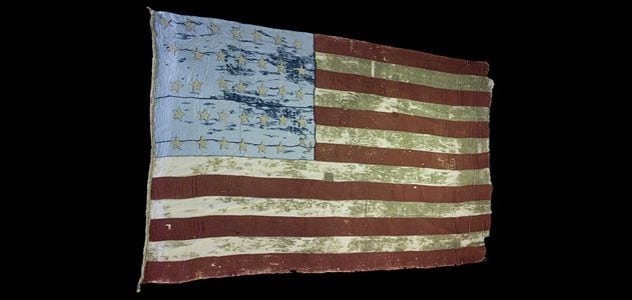
She has a name, and it isn’t the Star-Spangled Banner, as many believe. The flag of the United States of America is called Old Glory, but that name was never christened by Congress. Old Glory was a name given to a 3-meter by 5-meter (10 x 17 ft) flag owned by William Driver. Driver was a sea captain from Massachusetts who named his flag, and he even flew it as much as possible during the Civil War . . . in Tennessee! Old Glory flew on holidays for decades at the Driver home “rain or shine.”
After the state of Tennessee seceded from the Union, his flag became a target for local militias. Driver successfully hid the flag from vandals and kept it safe through multiple attempts. When Nashville fell in 1862, Driver approached the commanding general of the Union forces and presented his flag. Eventually, the war ended, and the flag flew over the Tennessee Statehouse. The story surrounding Driver’s struggle to preserve Old Glory and its survival led to all American flags adopting the name, and it’s all thanks to an American loyalist who survived the war in a Confederate state.[10]
Read about more interesting and notable flags on Top 10 Unusual or Unique Flags and Top 10 Controversial Flags.








